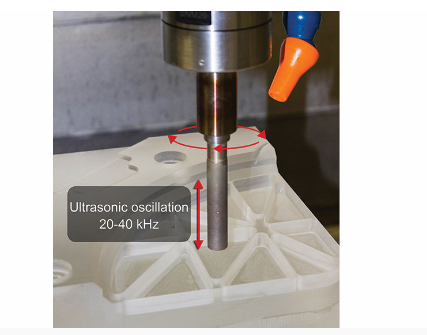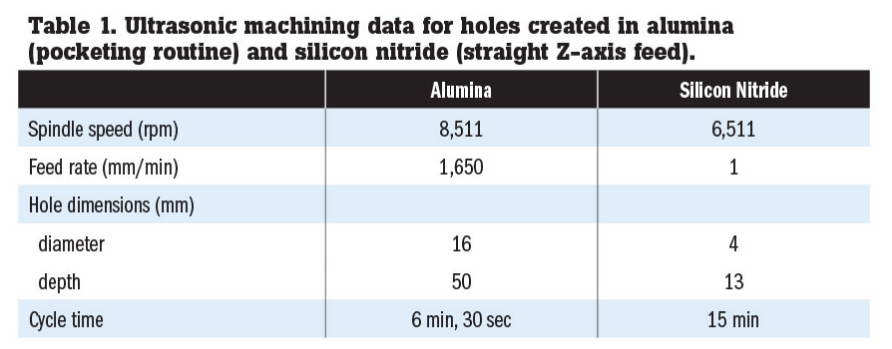
Best Way for Machining Ceramic Materials
Best Way for Machining Ceramic Materials
Ultrasonic machining technology can help manufacturers enhance throughput for advanced ceramic components.

From next-generation missile domes for defense systems to hip implant components for the medical industry, the mechanical properties of ceramic materials make them ideal for a wide range of applications. Ceramic materials such as aluminum oxide (alumina) and silicon nitride possess many beneficial qualities: extreme toughness, the ability to withstand high temperatures, and resistance to chemical corrosion, just to name a few. These properties, and others, make ceramics attractive to designers who need components with exceptional durability. Unfortunately, those same properties also present manufacturing challenges that can be difficult to overcome without the appropriate technology.

Components made from softer optical glass can be effectively manufactured with computer numerically controlled (CNC) machine tools using a rotating cutting tool impregnated with diamonds. However, when applying this method to ceramics, cutting tools wear at a much faster rate since the tool and workpiece endure greater forces due to the hardness of the material. To compensate for the increased force, machine operators must increase tool spindle speed while decreasing the cutting feed rate (the speed at which the tool is moved into the part). Ultimately, this results in longer cycle times and less efficiency.
Ultrasonic Machining
A technique known as ultrasonic-assisted machining can help overcome the challenges associated with traditional CNC machining. Ultrasonic machining centers* incorporate technology to cost-effectively machine ceramic components. Ultrasonic machining involves adding an up-and-down oscillation to the rotating tool, which allows for a freer cutting of these very hard materials.
The amplitude of the oscillations is small (micrometers) but effective in removing material when the tool is oscillating at its ideal frequency. Maintaining the ideal frequency, measured in kilohertz (kHz), ensures that the machine is performing at the highest efficiency and producing predictable results.
Proprietary software** determines the ideal oscillation frequency for each tool by performing a frequency sweep during the initial setup. The frequency sweep identifies the optimum frequency (typically between 20 and 40 kHz) by analyzing the size, shape, and mass of the tool being utilized for the job. Once the ideal frequency is determined and the cycle starts, the software automatically adjusts the frequency while the part is being machined in order to maintain peak ultrasonic machining performance. The shift in frequency can range from a few hertz to hundreds of hertz, depending on the change in machining conditions when the tool is in contact with the part.
Advanced machining processes for hard ceramic materials provide the following benefits:
Significantly reduced forces on the workpiece and tool during machining, which allows operators the freedom to increase processing speeds and cutting feed rates
Reduced cycle times, compared to standard grinding/milling machines
Minimal tool wear and longer tool life as a result of reduced force on the part and tool
Increased precision of the machined components due to more predictable tool life
Reduced tooling costs
Reduced spindle speeds, especially for holes as small as .007 in.
In addition, ultrasonic machining has shown improved surface quality compared to standard CNC grinding/milling. This is especially important when a subsequent polishing process is required to achieve the necessary part specifications. The more precise the part’s surface shape and roughness are after the grind process, the less time it will take to polish.
Testing and Results
Thorough testing has shown how using ultrasonic machining technology can increase the manufacturing efficiency of ceramic materials. In some cases, cycle times were reduced by 50% or more when compared to standard CNC machining. Two tests were recently conducted to evaluate the capabilities of ultrasonic machining in different cutting scenarios.
The first test involved ultrasonic machining of alumina. The alumina family of technical ceramics is grouped according to purity levels. Higher purity alumina is ideal for more demanding applications.1 To measure the benefit of ultrasonic machining, circular pockets that each had a diameter of 16 mm and a depth of 50 mm were machined into alumina. By adding ultrasonic assistance to a 12.7-mm diameter diamond tool, the spindle was set to 8,511 RPM with a programmed feed rate of 1,650 mm/min. Each pocket was completed in a cycle time of 6 min and 30 sec. By comparison, machining one of these holes using a conventional CNC milling machine took over 1 hr and required the tool to be replaced after each hole due to excessive wear. The diamond tool used on the ultrasonic machine showed very little wear after producing 12 holes.
The second test was done to determine the effectiveness of ultrasonic machining on silicon nitride. Silicon nitride has a unique grain structure that not only allows it to have exceedingly high toughness but also exceptionally high thermal shock resistance.2 In this test, a 4-mm diamond core drill performed a straight Z-axis feed into the part to create a hole with a depth of 13 mm. With ultrasonic assistance, the core drilling parameters included a spindle speed of 6,511 RPM and a feed rate of 1 mm/min. Although a 1 mm/min feed rate seems small, it is ideal given the extreme hardness of silicon nitride. At these parameters, the total cycle time to complete the hole was 15 min, three times faster than standard CNC machining.
Expanded Capabilities
As the market for ceramic components continues to grow, it is important that manufacturers are equipped with the latest technology. Ultrasonic machining centers provide more capabilities than standard CNC grinding/milling machines and are ideal for a variety of applications. Whether the need involves a light-weighted part, long cores, small holes, or complex geometric features, adding ultrasonic vibration to a diamond grinding tool enhances efficiency and increases tool life. Manufacturers that use ultrasonic machining centers can experience greater throughput of ceramic components while spending less time and money buying new tools.
Find a professional ulreasonic assisted machining for your application?
Click Altrasonic Assisted Machining to realize it !
© Copyright: 2024 Hangzhou Altrasonic Technology Co.,Ltd All Rights Reserved

IPv6 network supported
Scan to wechat
